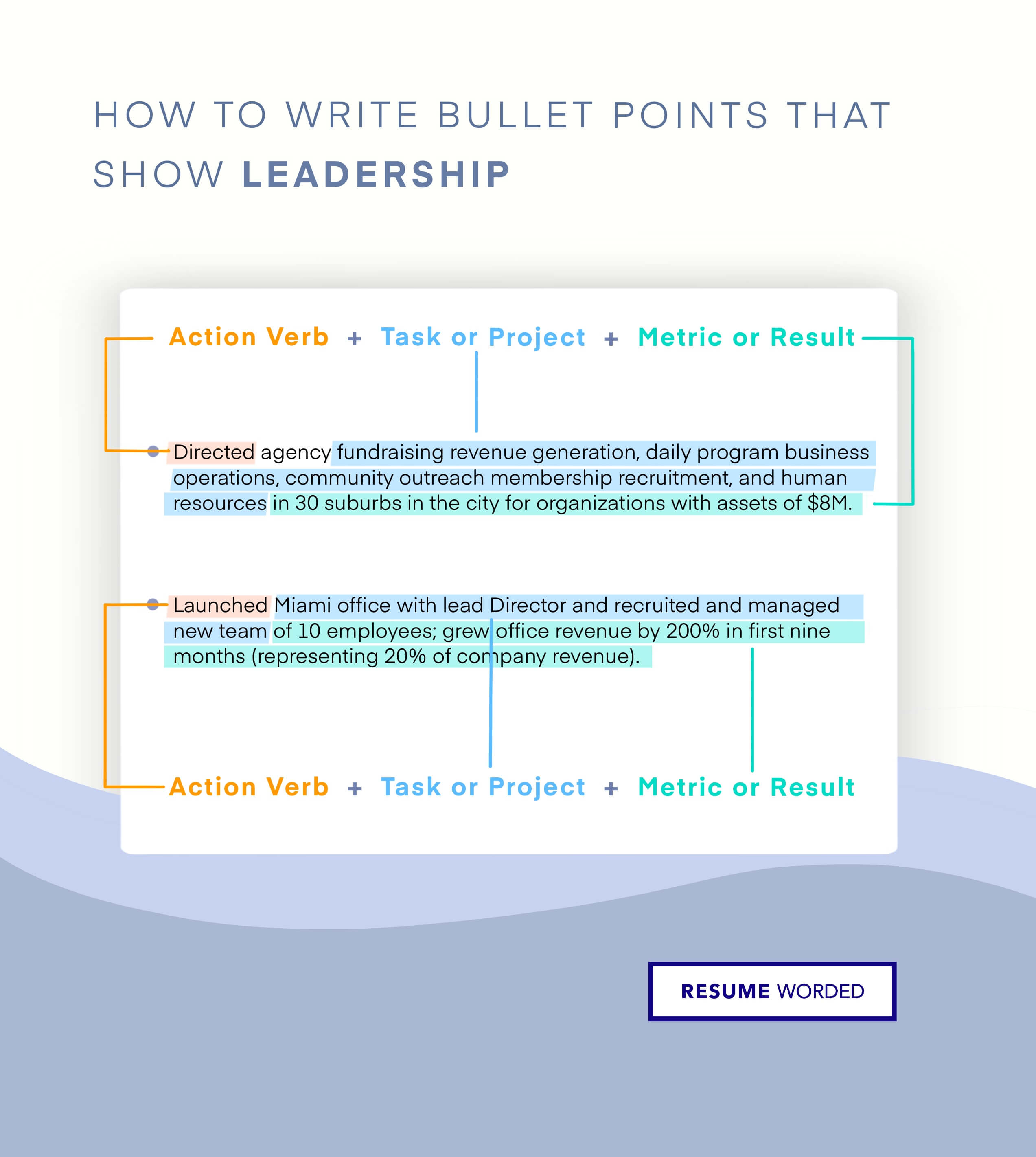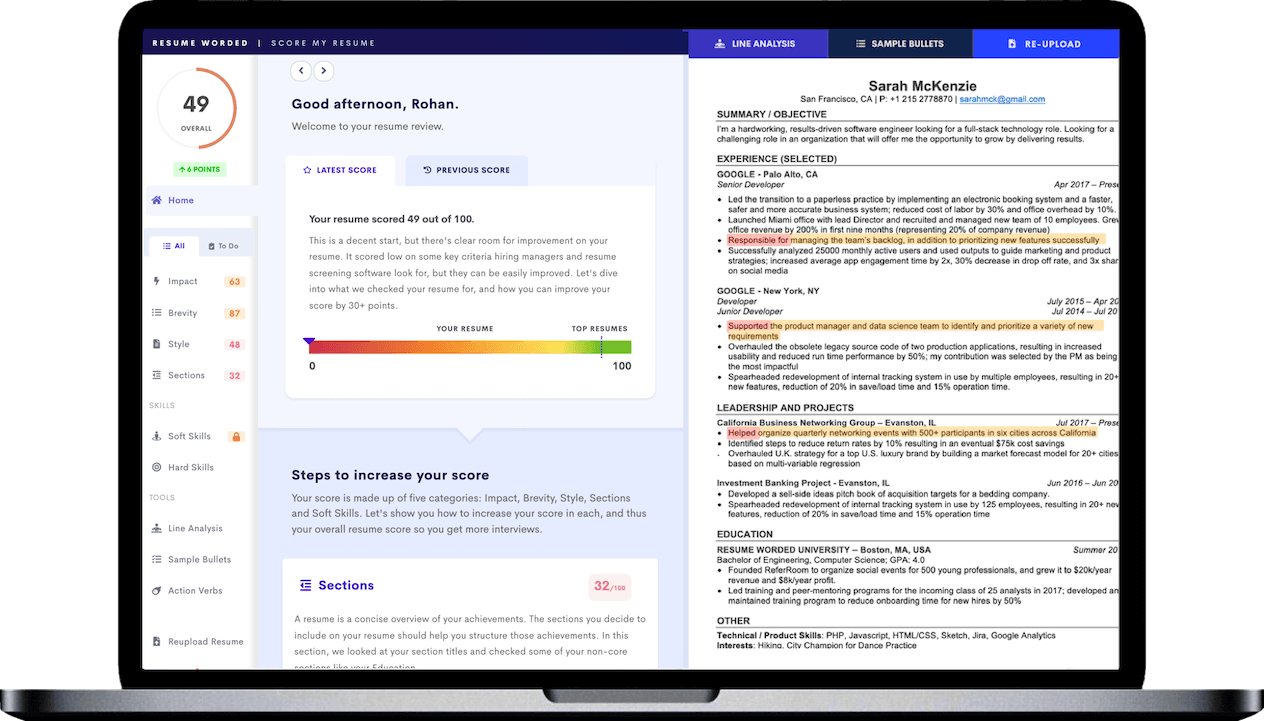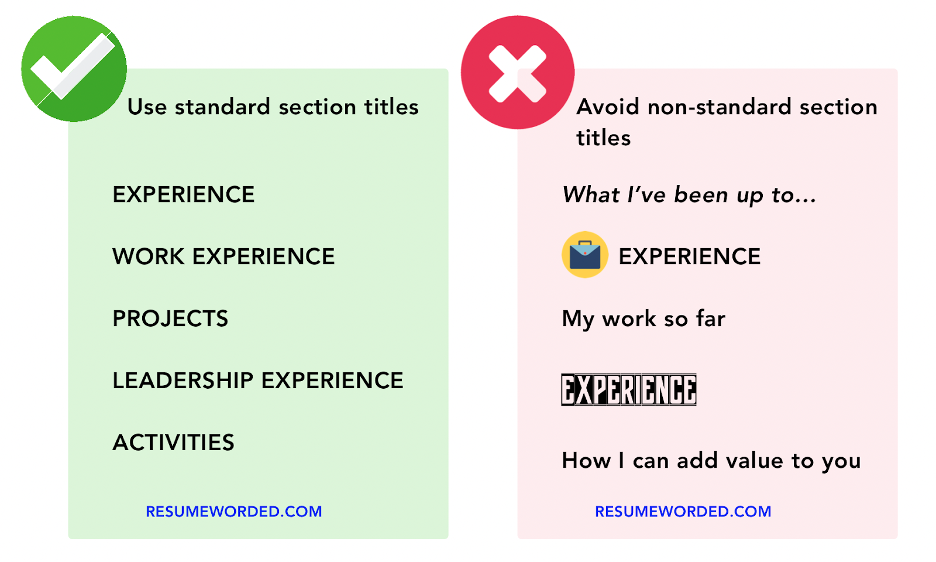Tutoring is a fantastic way to break into teaching or other roles that involve training and mentoring. But that’s not the only reason it belongs on your resume.
Tutoring involves a lot of in-demand transferable skills, from communication to flexibility to subject matter expertise. The key to putting tutoring on your resume is to identify which of these skills are the most relevant to the job you’re currently applying for and tailoring your experience to fit.
Let’s start with a quick step-by-step guide on how to do exactly that.
How to list tutoring on your resume: A step-by-step guide
- List all your tutoring experience: Include private, group, and one-on-one tutoring sessions.
- Analyze the job description: Match your tutoring experiences to the job description to identify what skills are most relevant to the position you're applying for.
- Identify industry-specific skills and keywords: Browse our database of skills and keywords to come up with a list of relevant keywords to include on your resume.
- Decide where to showcase your experience: Typically, this will be in your work experience section, but it can also fit under volunteer work or extracurricular activities.
- Describe your experience: List your employer, job title, and dates of employment (month and year are fine). Focus on achievements, using numbers and metrics whenever possible.
- Tailor for the role: Highlight specific skills and experiences that align with the job you’re applying for. For instance, emphasize leadership and mentoring skills for management roles or subject matter expertise for technical positions.
- Use an ATS resume scanner: This can help check your resume for any missing skills or keywords that could help you land the job.
Where to include tutoring on your resume
The best place to include tutoring on your resume will depend on what type of experience it is (e.g. paid vs unpaid). You can include tutoring experience:
- In your work experience section: Especially for paid tutoring roles.
- In a volunteering section: If the tutoring was unpaid or part of community service.
- In an extracurricular activities section: For tutoring experiences that showcase additional skills like leadership or initiative.
Avoid listing tutoring experience in your skills section, as it's not a hard skill. Instead, use your experience to emphasize relevant soft skills.Here’s an example of how to put tutoring experience in your work experience section:
And here’s an example of listing unpaid tutoring in a volunteering or extracurricular activities section:
You can also mention tutoring in other sections of your resume, depending on how much other experience you have to showcase and how relevant tutoring is to your application.
- In your resume summary: If tutoring is specifically relevant to the position you’re applying for, begin your resume with a summary that highlights your key tutoring skills. For example, "Experienced tutor with a proven track record in fostering student improvement in Mathematics, demonstrating strong analytical and communication skills."
- Under achievements or certifications: If you have received any awards, recognitions, or certifications relevant to your tutoring, include these to demonstrate your experience.
Why you should put tutoring on your resume
Tutoring experience can be a great asset to any resume, regardless of the field or industry you're applying to. Tutoring demonstrates a range of in-demand transferable skills like communication, problem-solving, adaptability, and the ability to work independently, which are relevant to pretty much every profession.
Tutoring experience can be particularly helpful if you have limited paid work experience, as you can showcase these competitive skills in a semi-professional manner. Tutoring can also help you fill an employment gap and show that you've been proactive in developing skills during your career break.
How to describe tutoring experience on your resume
When describing your tutoring experience on your resume, it's important to focus on the skills that are relevant to the job you are applying for. This can include the subject matter you tutored, the scope of your experience, and the transferable skills you developed through tutoring.
Focus on relevant skills and experience
Tutoring can be relevant to your application for many reasons:
- The tutoring itself is relevant, e.g. you’re applying for roles in education or training.
- The subject(s) you tutored are relevant and demonstrate subject matter expertise, especially if you tutored at college level or higher.
- You can use your tutoring to demonstrate relevant transferable skills, such as: communication, problem-solving, time management, adaptability, flexibility, organization, patience, leadership, mentoring, and critical thinking.
The easiest way to find out what skills and experience are most relevant to the job you’re applying for is to use our skills and keywords finder, which allows you to search by industry or job title.
Quantify your accomplishments
Quantifying your resume with metrics and numbers is crucial as it provides a recruiter with tangible evidence of your skills. This is especially important for tutoring experience, as it helps potential employers see why your experience is relevant.If you’re struggling to pull concrete metrics out of your tutoring experience, consider:
- The number of students you tutored
- How many classes or group sessions you taught
- How frequently you led tutoring sessions
- What level or type of qualifications you tutored people for
- The number or percentage of students who successfully completed their qualifications
- The level of achievement of your tutees
Quantify your soft skills
While quantifying accomplishments can be straightforward, conveying soft skills such as communication, patience, and adaptability can be more challenging. To quantify these types of soft skills, use descriptions of specific scenarios or achievements and explain how your actions led to favourable results. For example:
- Communication: Facilitated a diverse group of 15 students in collaborative learning sessions, enhancing their collective understanding and engagement, improving class participation by 50%.
- Patience: Successfully guided a student with learning difficulties through a comprehensive math curriculum, achieving a 30% improvement in their test scores.
- Adaptability: Designed and implemented a flexible tutoring program that accommodated the varying schedules and learning styles of 20 students, leading to a 100% pass rate in their respective examinations.
Group similar tutoring roles together
If you’ve tutored multiple clients, you don’t need to list each one separately. It’s often easier and neater to list significant accomplishments by grouping similar roles together on your resume. This is especially relevant if you want to put private tutoring on a resume, or if you have a lot of tutoring experience in different contexts.
For example, if you spent a couple of years doing group tutoring sessions and had a few private tutoring clients on the side, instead of listing those as separate positions, you might want to group them under a single heading, like “SAT Tutor.” Use whatever job title makes sense based on your area of expertise, e.g. English Tutor, STEM Tutor, K-12 Tutor.
Use the right tools to strengthen your resume
Including tutoring experience on a resume is a great way to highlight soft skills — like communication and teamwork — that hiring managers are always looking for. Find out how well your resume conveys the right information by uploading it to the free tool below.
Tutoring bullet point examples
Looking for concrete examples of accomplishments to list on your resume? Use these as a jumping-off point.
How to put group tutoring on your resume
If you tutored people in a group setting, include the number of students you had and what you were tutoring them for.
Tutored 30+ students for GCSE, A-Level and Degree Level examinations in Mathematics.
How to put private tutoring on your resume
If you were a private tutor, you can include a little more detail about what you were tutoring people for and what they achieved.
Coached 2 students to the final round of the Olympiad (BMO2).
How to put online tutoring on your resume
If you have experience with digital tools and online tutoring, make sure to describe the scope of your experience, the specific tools you used, and how you adapted your tutoring skills to online formats.
Conducted online tutoring for groups of 15+ students in calculus, using platforms like Zoom and interactive whiteboards to facilitate learning.
Transitioned to online tutoring during remote learning periods, maintaining high student engagement and success rates.
How to put peer tutoring on your resume
Peer tutoring still belongs on a resume, especially if it was a regular (and not just one-off) occurrence.
Tutored 10+ students in computer science and economics, resulting in 100% pass rate.
How to put tutoring multiple grades or subjects on your resume
Don’t be afraid to put tutoring on your resume even if you didn’t have one particular area of expertise. Include the most relevant subject(s) you tutored and the grades or age ranges of your tutees.
Tutored students from K-12 in Physics, Chemistry, Biology, and Mathematics.
How to put college tutoring on your resume
If you tutored professionally or at a high level, include the subject(s) you taught — especially if you’re now applying for roles in a related industry.
Taught 2 classes of 45+ students per semester in research methods and analytics.
How to tailor your tutoring experience to specific jobs and industries
Tailoring your resume to each individual application is an essential part of a high-performing resume. Modern recruiters don’t want to see a list of every job you’ve ever done, but rather a relevant list of skills that clearly show why you’ll be good for this particular role.
- Understand the industry: Analyze the job description and research the industry you are applying to. Identify essential skills, qualifications, and experiences that are valued in these roles. For example, if you are applying for a finance role, emphasize your experience in tutoring mathematics or economics. For a position in IT, highlight any tutoring you did in computer science or technology-related subjects.
- Highlight relevant skills: Match your tutoring skills with the ones sought in your target job. For example, if the job requires strong communication skills, highlight how you communicated complex concepts effectively to students of varying levels.
- Use industry-specific language: Use terminology and keywords that are specific to the industry or job you’re targeting, to show your understanding of the industry and help your resume get past ATS scanners.
Examples of tailoring your tutoring experience to different jobs and industries
Here are some examples of how tutoring skills can be adapted and highlighted for different industries and sectors:
Corporate roles
In corporate environments, skills such as leadership and analytical thinking are highly sought after. Describe your experience organizing and leading tutoring sessions and solving problems for your students.
Focus: Leadership, analytical thinking, problem-solving, and communication skills.
Led a series of advanced economics tutoring sessions, enhancing critical thinking and analytical skills, directly contributing to a 40% improvement in students' grades.
Academic roles
Tutoring is highly relevant to academic positions, not only to show your deep understanding of the subject matter but also your ability to develop and deliver educational content.
Focus: Subject expertise, curriculum development, and pedagogical skills.
Developed an innovative curriculum for teaching advanced chemistry, integrating practical experiments that align with current academic standards, resulting in a 35% increase in student engagement and comprehension.
Management positions
Management roles demand strong leadership and the ability to organize teams effectively. Describe your experience managing tutoring programs or leading teams of tutors or students to showcase your strategic planning and coordination skills.
Focus: Leadership, organizational skills, team management, and strategic planning.
Coordinated and managed a team of five tutors, developing strategic teaching plans that improved overall student performance by 30%.
Tech roles
The tech industry requires technical expertise, creative problem-solving, and the ability to communicate complex technical information. Tutoring experience, even if not directly tech-related, is a great way to show these skills.
Focus: Technical expertise, problem-solving, and the ability to convey complex information simply.
Conducted specialized tutoring in Python programming and data analysis, adapting teaching methods to various skill levels, which significantly enhanced students' practical skills.
Virtual and remote work
Virtual and remote roles require digital communication, strong time management, and the ability to work independently. Discuss your experience managing virtual tutoring sessions and online resource management, and make sure to list the digital tools you are proficient with.
Focus: Digital communication skills, time management, and self-motivation.
Successfully managed a virtual tutoring program for 20+ students across different time zones.
Finance roles
In finance, the ability to understand and communicate complex financial concepts is essential. Mention your experience with financial subjects like economics or accounting to show your ability to understand complex financial information.
Focus: Analytical skills, financial concepts, attention to detail, and the ability to interpret and communicate complex data.
Specialized in tutoring advanced financial and accounting principles, resulting in a 25% increase in students' comprehension and application of financial concepts.
Law roles
The legal sector requires a deep understanding of law, critical analysis, and the ability to communicate complex legal issues. Highlight any experience teaching corporate and international law, breaking down challenging legal theories, and applying these concepts in practical scenarios.
Focus: Understanding of legal principles, critical thinking, attention to detail, and effective communication of complex legal concepts.
Led tutoring sessions focused on corporate and international law, employing case studies and current legal scenarios to elucidate complex legal theories, leading my students to succeed in moot court competitions.










